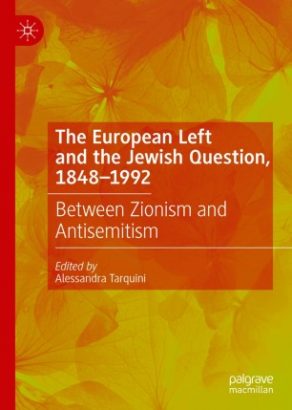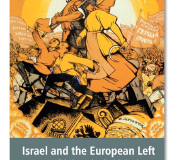While many look to the rise of both Bolshevik Russia and Nazi Germany to understand the Left’s evolution on the Jewish question, one period of time that is often overlooked is that of fin de siècle France and Italy — the opening of a century disfigured by the Shoah and the murder of millions of innocents.
While it can be argued that the First Zionist Congress, the founding of the Bund and the Russian Social Democratic Labour Party in 1897-1898 all presented paths to the Jewish future, the ideological turmoil in France and Italy after the deaths of Marx and Engels coloured the trajectory of the European Left at the onset of the twentieth century.
During the nineteenth century, France had had its fair share of anti-Semites on the Left such as Alphonse Toussenel and Pierre-Joseph Proudhon. Charles Fourier, the instigator of a utopian socialism, termed the Jews ‘a parasitic sect’. French history from the defeat in the Franco- Prussian war to the Dreyfus Affair to the Petàinist regime in 1940 is peppered with the obsession of discovering the hidden Jewish puppet masters — and making them pay for their disloyalty.
Michel Dreyfus, in an excellent essay, explains that this path was not linear, but notes that anti- Semitism in France regained momentum during the inter-war period. The French Right which had always regarded the verdict in the Dreyfus Affair as ‘a judicial coup d’état’, blossomed. Figures such as Edouard Drumont, Maurice Barrès and Charles Maurras feared that the Jews would gain influence in France as a social class rather than as a religious community.
Michel Dreyfus argues that Poland, Germany and Austria all revelled in anti-Semitism after 1933 and France and Italy after 1937. With the exception of the Protestant areas of Germany, these were all Catholic countries.
In fin de siècle France, figures such as Gustav Le Bon and Georges Sorel were instrumental in determining the path of the European Left. In an essay about Sorel, Luca Basile illustrates the peaks and troughs in his attitude towards the Jews. His followers, Hubert Lagardelle and Robert Louzon, believed that ‘the Jews polluted the workers’ movement through compromise, opportunism and bourgeois collaborationism’. Sorel facilitated the drift of many on the Left to the Right. After all, Mussolini at that time was proud to call himself a socialist.
Michel Dreyfus also draws attention to the post-1945 Left in France, submerged in a wider fog about forgetting French complicity in the deportation of its Jewish community and a minimising of the Shoah. Some such as Paul Rassinier, Pierre Guillame and Roger Garaudy rationalised their positions by transitioning from the far Left to the far Right. Dreyfus notes that there have been recent killings of Jews in Toulouse, Montauban and Vincennes, that the Revolutionary Communist League refused to protest about the murder of llan Halimi in 2006, that thousands chanted ‘À mort, les Juifs’ during a ‘Day of Anger’ in 2014.
Michel Dreyfus argues that the `Affair’ of his namesake and the terrible events during World War II were believed by many on the Left to have psychologically put the question of anti- Semitism to bed after 1945. The distance of time however and the disappearance of the soixante huitards — the 1968 generation, disproportionately Jewish — led subsequently to the abandonment of the war against fascism and anti-Semitism during the 1990s. Recent times have heralded the advent of identity politics, the support of an lslamist Left and a crude reductionism in a post-colonialist understanding of Israel and Zionism.
Other conflicts such as those between Iran and Iraq during the 1980s, Bashar Assad and his opponents in Syria and the Algerian civil war have been selectively played down. Dreyfus makes the incisive point that a lack of interest in investigating anti-Semitism on the Left by historians is ‘primarily ideological’. Indeed David Baddiel’s Jews Don’t Count came as a revelation to many British citizens in 2021.
There is a parallel in this outlook when some pacificists in the 1930s condemned Jews for wishing to provoke a war with Hitler. Nazi excesses were thereby marginalised because the painful vision of the slaughter in the trenches during World War I was far more vivid. This mindset became ‘a vector of anti-Semitism’.
There are some marvellous essays in this book as to how Italian socialists reacted to the Jewish question in the past. Xavier Tabet writes about Cesare Lombroso, ‘the father of criminal anthropology’. Lombroso was Jewish, believed that assimilation was the best way forward and described ‘the defects of the Jew’ as ‘greed and an aptitude for theft’. Circumcision was merely ‘a hangover from cannibalism’. He believed in the development of a new faith, ‘stripped of ancient and ridiculous rites’ — a ‘socialist neo-Christianity’ which would embrace both Christians and Jews.
The Jewish Lambroso was in hindsight a cog in the onward drift towards the birth of fascism via the vehicle of revolutionary syndicalism. A sizeable minority of Rome’s Jews later greeted Mussolini’s rise to power — the anti-Jewish legislation was far in the future.
The Italian Marxist thinker, Antonio Gramsci, is rightly lauded today by the European Left. He wrote 30 notebooks while in Mussolini’s prisons and argued that the defeat of the Paris Commune in 1871 had ignited the split in socialism, giving birth to fascism. He characterised Sorel as someone who was infused by an ‘anti-historical anti-Jacobinism’.
Andrea Pinazzi has examined Gramsci`s correspondence with his wife, Lulca and his sister-in- law, Tatiana Shucht who was of Jewish origin. Shucht and Gramsci discussed the film, Two Worlds (1930), by the German Jewish filmmaker, G. A. Dupont, which raised the Jewish question. Pinazzi suggests that Gramsci’s responses were very basic, shaped by a Catholic anti-Judaism and Marx’s ‘resolution of the Jewish problem’. Gramsci had read Henry Ford’s The International Jew — and reduced the author’s anti-Semitism to merely a fight against finance.
Pinazzi also suggests that Gramsci in prison did not confront the Jewish question as posed by
the rise of fascist anti-Semitism. It seems that Gramsci like many of his contemporaries were happier leaving the Jewish question within the realm of theory rather than the here-and-now of the fascist present.
During the post-war period, Natalia Ginsburg’s article, ‘Il figlio dell’uomo’, in the Communist daily L’Unita detailed the persecution of the fascist era and the murder of her husband in the prison at Regina Coeli, but said nothing about anti-Semitism. Similarly Alberto Moravia in his essay, ‘l’uomo come fine’ preferred to discuss the destruction of the Jews as an expression of dehumanisation rather than one of genocide.
This began to change in the early 1960s with a spate of anti-Semitic daubings, the Eichmann trial in Jerusalem and the efforts of Pope John XXIII to eradicate the historic hostility of the Catholic Church towards the Jews. Even so, in 1964, when Rolf Hochhuth’s play The Deputy which highlighted the Vatican’s millennial anti-Judaism, the Italian authorities censored it despite the fact that it had been performed in London and elsewhere.
Gramsci was a founder of the Italian Communist party in 1921 together with Palmiro Togliatti and Umberto Terracini. Another contributor to this book, Marta Nicolo, has written an extremely interesting essay about Terracini who spent 11 years in Mussolini’s prisons and another six in confinement before emerging as a leading parliamentarian in post-war Italy. Terracini was a Jew who went to a Jewish school and attended synagogue before discovering Marxism-Leninism. Unlike many other Jewish Communists who buried their Jewishness along with their heads in the sand, Terracini exhibited a lifelong concern for Jews — and remained a Communist until his dying day.
Terracini opposed the Nazi-Soviet pact in 1939 which caused him ‘moral suffering’ and was consequently ostracised by fellow Italian Communists. He opposed the reintegration of Nazi war criminals into normal life and pressed for an extension of the statute of limitations. He campaigned without success against the release of Field Marshal Albert Kesselring, commander of the German forces in Italy after 1943 — someone who was held responsible for war crimes such as the massacre of 335 Italians at the Fosse Ardeatine in March 1944. In late May 1948, Terracini asked why the Italian parliament had not recognised Israel and spoke out against the Vatican’s attitude towards the Hebrew Republic. He thought that Krushchev’s condemnation of Stalin at the Twentieth Soviet Party Congress in 1956 had not been strong enough and was a very early campaigner for the emigration of Soviet Jews. In 1969, Terracini condemned Saddam’s hanging of Iraqi Jews in Baghdad. In 1975, he condemned the ‘Zionism is Racism’ resolution at the United Nations.
Like Moshe Sneh, Umberto Terracini’s political odyssey did not fit perceived expectations and he followed his own path even when the Italian Communist Party muted itself during the Black Years of Soviet Jewry (1948-1953) and during the Slánský trial in 1952. At that time a third of the Italian electorate voted for the Communists and its allies.
While this book purports to be an examination of the European Left and the Jewish Question, it is much more about France and Italy with a brief peek-in by the German and Spanish Lefts. The folly of Brexit seems to mean in this instance the geographical disappearance of the United Kingdom from the European continent — for there is no essay or reference in this work to the travails of the British Left and its attitude towards Jews.
The publisher, Palgrave Macmillan, has also allowed through a very poor translation into English of the essays and permitted some strange editing. The scholars who have contributed to this excellent work deserve better. Despite this, the essays are deeply interesting and shed new light on the continuing and tortuous relationship between the European Left and the Jews.




































